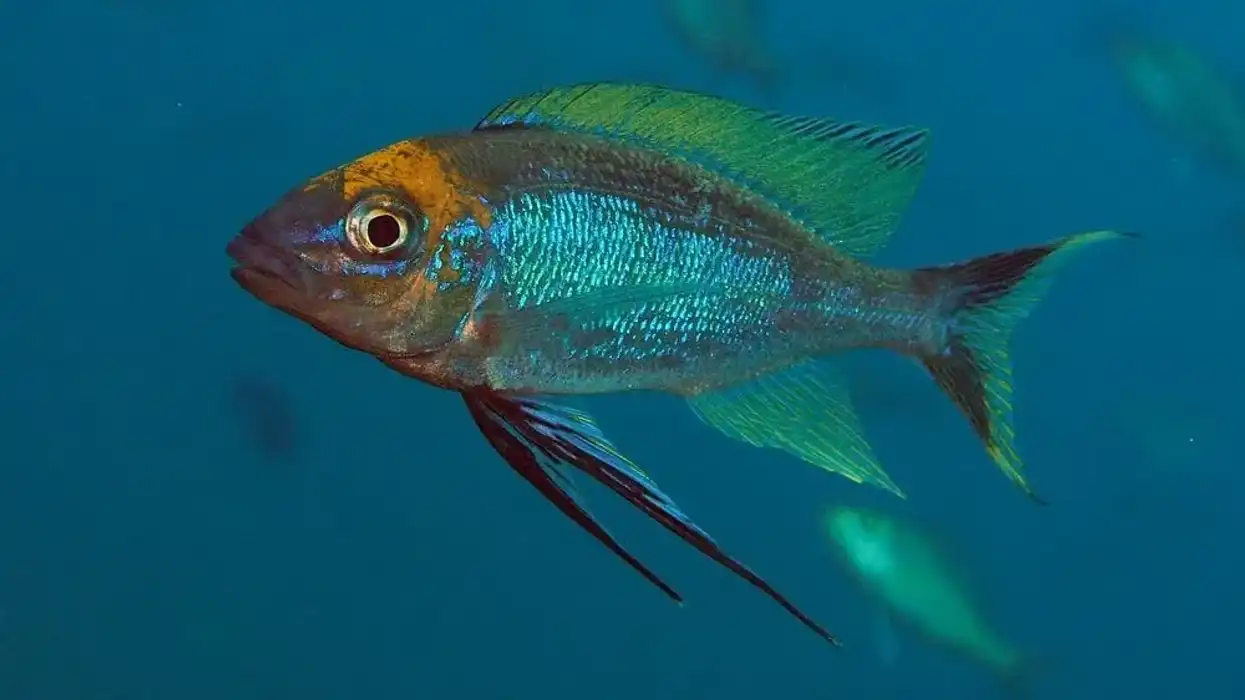The striped kingfisher belongs to the order Coraciiformes, the family of colorful birds. Other birds of this species are the rollers, motmot, bee-eaters, and finally, other kingfishers.
The striped kingfisher is famously associated with popular Greek mythology as the bird that nested on the sea and it was named 'halcyon'.
The word was used to associate with the kingfisher in the legend. The legend narrates the story of Alcyone, the daughter of the God of wind, and Ceyix, the son of the morning star.
Upon getting married, they committed the mistake of pronouncing themselves as Zeus and Hera, which angered Zeus, leading him to punish the two resulting in Alcyone's death by drowning in the sea. However, the other Gods showed mercy upon them and let them be reincarnated as kingfishers.
Thereafter, she came to be known as Halcyon.
It is believed that Halcyone later laid her eggs on a floating nest in the sea while her father, the God of winds, kept the sea winds in check to help his daughter. The legend of Halcyon 'calming the sea' is a popular one.
Besides Greek mythology, some of the histories of this bird are known to hail from Chelicut. The species has been renamed in several other cultures like Chelicuti, after its place of origin Chelicut with Halcyon chelicuti and Alaudo chelicuti being its protonyms and the French martin chasseur strié which also classifies the kingfisher bird family.
Find this article about the striped kingfisher interesting? Check out some more fun bird facts about the cockatoo and blue jay.
Striped Kingfisher Interesting Facts
What type of animal is a striped kingfisher?
The striped kingfisher is a kind of bird that goes by the genus name Halcyon.
What class of animal does a striped kingfisher belong to?
The striped kingfisher belongs to the Aves class, which is the bird family.
How many striped kingfishers are there in the world?
The striped kingfisher species is spread far and wide across Asia. They have a very high rate of occurrence, which makes it difficult to give an exact count for the species. They are not a rare sight.
Where does a striped kingfisher live?
The bird inhabits the southern regions of Africa, South Africa, the Namib desert, areas surrounding the Kalahari desert, Okavango delta, Damaraland, and Namibia. In the locations of the Okavango delta and Botswana, the bird is found in wildlife parks, reserves, and sanctuaries. Chobe National Park, Linyanti reserve, Moremi reserve, and Kalahari game reserve are some prime locations.
What is a striped kingfisher's habitat?
The striped kingfisher habitat is mainly based in thorny scrubs, dry bush, woodland, and open savannas. The bird perches amongst the shallower half of the canopy and avoids locations like cultivated farms even though it prefers open areas. Mythically believed to be nested on the sea, it actually lays its eggs around the sea on the coasts.
Who do striped kingfishers live with?
These southern African birds are highly territorial species and do not tolerate any other bird in their territory. They are known to be uncooperative, even with their own kind. These birds are known to chase out any intruder like the dove and lilac-breasted roller.
How long does a striped kingfisher live?
The average striped kingfisher can live up to 12-15 years. The longest living kingfisher in the world was a common kingfisher which was known to live up to 21 years!
How do they reproduce?
The breeding season for the striped kingfisher begins in November and lasts until February. An average striped kingfisher adult reaches reproductive maturity at the age of one.
Every year, these birds lay around three to six eggs and the gestation period lasts for 18-20 days. Their might be multiple breeding periods throughout the year. The nestlings remain in the nest for the next 25 days until they are ready to take off.
Unlike popular myths, the striped kingfisher does not really lay its eggs on a floating nest on the sea. Instead, they nest in areas surrounding the water bodies.
Interestingly, this species is a nest parasite, meaning they look for abandoned nesting sites for breeding. The striped kingfisher is known to dwell in tree cavities, abandoned nests of woodpeckers and barbets.
What is their conservation status?
The striped kingfisher is the bird with the most diverse range among the kingfisher bird family, and their conservation status is of Least Concern.
Striped Kingfisher Fun Facts
What do striped kingfishers look like?
The striped kingfisher is a tiny bird that is a combination of brown, blue, white, and hues of light brown. They have a dark brown crown, whitish-brown nape running all the way down to the underbelly.
The wings and upper parts are dark brown with striped flight feathers that are a combination of white and brown, and the under tail is blue. It has a distinctive beak, with the lower bill of the beak being red. This sets it apart from other birds like brown-hooded and blue-breasted kingfishers.
How cute are they?
The kingfisher striped is not the most attractive species of its genus, but they are fairly pretty birds. They are tiny and conical that makes them appear cute.
How do they communicate?
The striped kingfisher is only known to communicate with its mate. They communicate through a long shrill call, and there are only a few instances of communication among these birds outside their pairings.
How big is a striped kingfisher?
The kingfisher striped belongs to the Coraciiform order. Accordingly, the striped kingfisher size is the smallest in their genus. If compared with one of the biggest species of the genus, hornbills, the striped kingfisher is almost 10 times smaller at 6.5-8.5 in (16-18 cm).
How fast can a striped kingfisher fly?
The flight of the kingfisher striped is swift, direct, and usually on the lower stratas. Its speed is around 36 mph (57.9 kph).
How much does a striped kingfisher weigh?
Generally, the striped kingfisher weighs around 1.1-1.6 oz (34-46 g).
What are the male and female names of the species?
Both male and female kingfishers are known by the common name, with the genus name Halcyon.
What would you call a baby striped kingfisher?
The baby striped kingfisher is generally known as nestling or chick.
What do they eat?
Their common food is insects and smaller invertebrates. They have evolved to consume a larger variety of food items like lizards. However, they are predated on by foxes, snakes, and raccoons.
Are they dangerous?
No, they are harmless to humans.
Would they make a good pet?
They could make good pets, but they are the birds of the wild, so it's preferable not to keep them as pets.
Did you know...
The name Chelicut Kingfisher was given by Edward Stanley and Lord Stanley on their voyage to Abyssinia in the 19th century. The striped kingfisher (protonym Alaudo chelicuti) is not a foraging bird, rather, it hunts its prey mid-air and brings it back to the tree to eat it.
The kingfisher species ranges across 114 species!
A song titled 'French Martin Chasseur Strié' is composed of the voices of the bird.
How many types of kingfishers are there?
Striped kingfishers have a wide range and population, and there are around 114 species of kingfishers in the world. Similar species to striped kingfishers are the brown-hooded kingfisher, the blue-breasted kingfisher, the woodland kingfisher, and the gray-headed kingfisher.
The common feature among all these birds is a stripe-like structure, be it on different parts of the bodies and a uniting blue under the tail.









